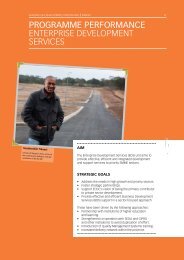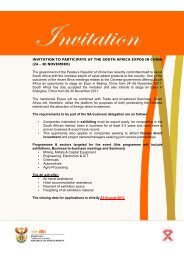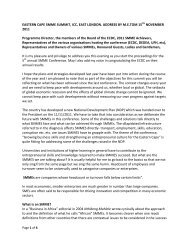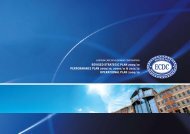2007 / 2008 Annual Report - Eastern Cape Development Corporation
2007 / 2008 Annual Report - Eastern Cape Development Corporation
2007 / 2008 Annual Report - Eastern Cape Development Corporation
- No tags were found...
Create successful ePaper yourself
Turn your PDF publications into a flip-book with our unique Google optimized e-Paper software.
EASTERN CAPE DEVELOPMENT CORPORATION <strong>2007</strong>/08CONSOLIDATED ANNUAL FINANCIAL STATEMENTSFOR THE YEAR ENDED 31 MARCH <strong>2008</strong>ACCOUNTING POLICIES1.6 Impairment of assetsAn impairment loss on an asset or cash-generating unit is the amount by which the carrying amount, i.e. the amountrecognised on the balance sheet after deducting any accumulated depreciation and accumulated impairment losses,exceeds its recoverable amount. The recoverable amount is the higher of an asset’s or cash-generating unit’s fair valueless costs to sell and its value in use. Value in use is the present value of future cash flows expected to be derived froman asset or cash-generating unit.At each reporting date the carrying amount of the tangible and intangible assets are assessed to determine whetherthere is any indication that those assets may have suffered an impairment loss. If any such indication exists, therecoverable amount of the cash-generating unit to which the asset belongs is estimated. Value in use is estimatedtaking into account future cash flows, forecast market conditions and the expected useful lives of the assets.If the recoverable amount of an asset (or cash-generating unit) is estimated to be less than its carrying amount, thecarrying amount is reduced to the higher of its recoverable amount and zero. Impairment losses are recognised in profitor loss. The loss is first allocated to reduce the carrying amount of goodwill and then to the other assets of the cashgeneratingunit. Subsequent to the recognition of an impairment loss, the depreciation or amortisation charge for theasset is adjusted to allocate its remaining carrying value, less any residual value, over its remaining useful life.If an impairment loss subsequently reverses, the carrying amount of the asset (or cash-generating unit) is increasedto the revised estimate of its recoverable amount, limited to the carrying amount that would have been recognisedhad no impairment loss been recognised in prior years. A reversal of an impairment loss is recognised in profit or loss.Impairments to goodwill are not reversed in subsequent accounting periods.1.7 Financial instrumentsFinancial assetsFinancial assets and financial liabilities are recognised on the Group’s balance sheet when the Group becomes party tothe contractual provisions of the instrument.Financial assets are initially measured at fair value plus transaction costs. However, transaction costs in respect offinancial assets classified as at fair value through profit or loss are expensed.Investments classified as held to maturity are measured at amortized cost less any impairment losses recognised.Available for sale financial assets are measured at fair value with gains or losses being recognised directly in equity. Fairvalue, for this purpose, is market value if listed or a value arrived at by using appropriate valuation models if unlisted.Impairment losses are recognised in profit or loss when there is objective evidence that the asset is impaired. Anyreversal of impaiment losses is recognised directly in equity.Loans advanced are stated at the outstanding capital amount and accrued interest after deduction of amounts which,in the opinion of the directors, are required as specific impairment allowances. Specific impairment allowances aremade against identified doubtful advances. The aggregate impairment allowances, which are made during the year, lessamounts released and recoveries of advances previously written off are charged to the income statement. Irrecoverableadvances are written off as irrecoverable when the extent of the loss has been confirmed.Cash and cash equivalents are measured at fair value, with changes in fair value being recognised in profit or loss.Financial liabilitiesFinancial liabilities are initially measured at fair value plus transaction costs. However, transaction costs in respect offinancial liabilities classified as at fair value through profit or loss are expensed.Financial liabilities that are not designated on initial recognition as at fair value through profit or loss are measured atamortised cost. Financial liabilities that are designated on initial recognition as at fair value through profit or loss aremeasured at fair value, with changes in fair value being recognised in profit or loss.78
















